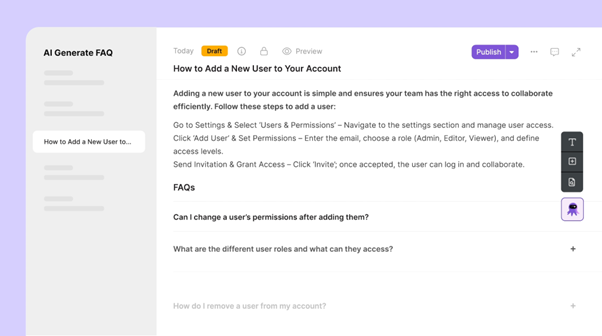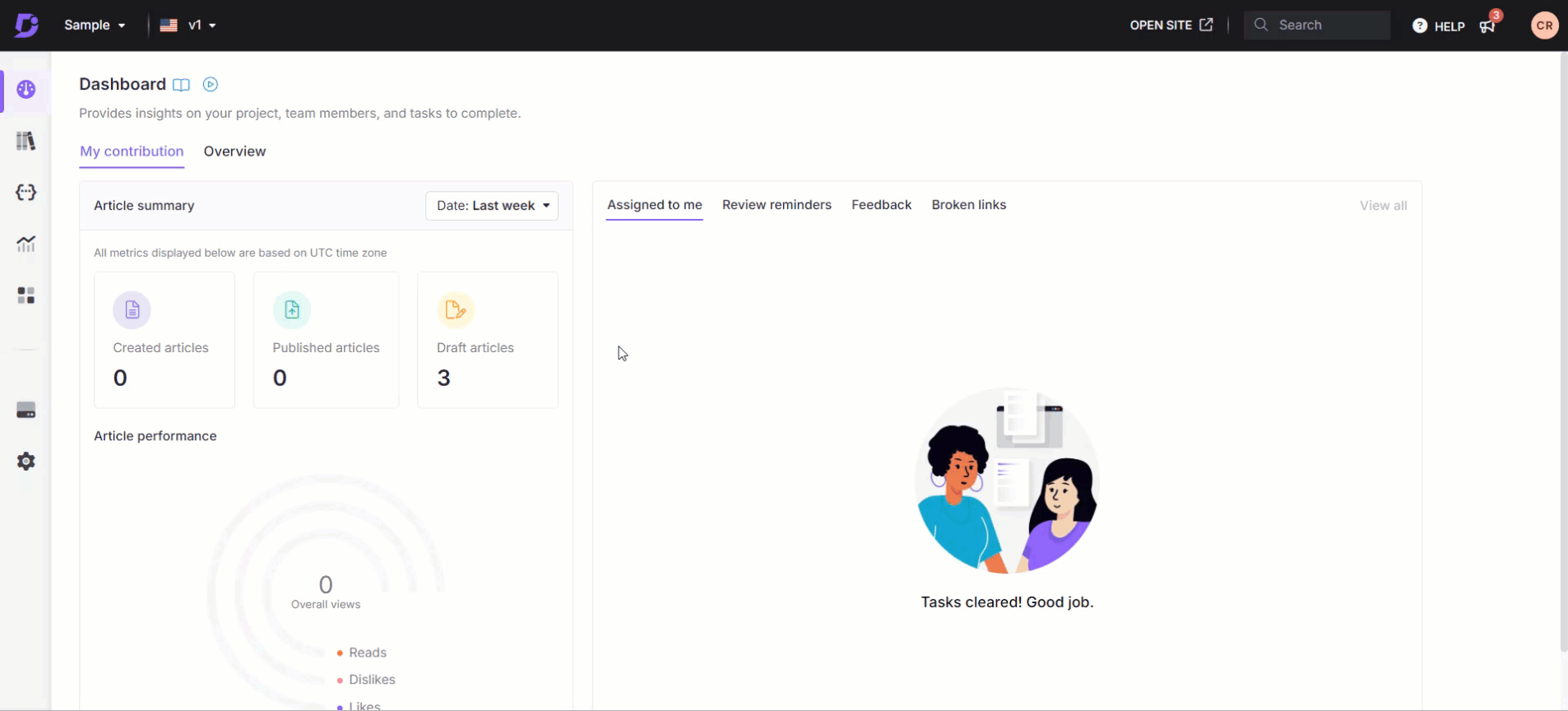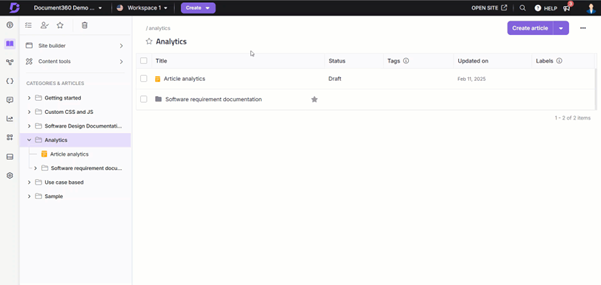Do you want to create a knowledge base that delights your users instead of frustrating them? Or you want to improve your existing knowledge base by identifying the pitfalls that are making it ineffective?
With this article, we will help you do both by discussing the common knowledge base mistakes, how to avoid them, and what to do instead.
As a customer support leader or operations manager, you are always looking to optimize your help centers and reduce support costs, and knowledge bases can go a long way in helping you do that. Gartner reports that good use of a knowledge management system can lower operating costs by 25%. This means customers can quickly and easily find the information they need.
And the good news is, this is what customers want too. 67% of users prefer self-service support, with 91% saying they would use a knowledge base.
So, let us get into the details of building a great knowledge base by avoiding the most common pitfalls. Here we go!
📋 TL;DR
Mistakes to avoid in a knowledge base and what to do instead.
- Avoid writing too complex or technical content. Keep it simple.
- Don’t turn your knowledge base into an endless FAQ list. Include varied components.
- Poor knowledge base structure and navigation don’t work. Strategize carefully.
- Keep your articles updated and your content format consistent.
- Do not ignore user feedback and analytics. Use it to improve your knowledge base regularly.
- Ensure that your knowledge base is accessible to all users in all ways possible.
- Don’t ignore its SEO potential. Optimize it to attract new customers and build authority.
The Most Common Knowledge Base Mistakes to Avoid
A good knowledge base can go a long way in delighting your users, saving time, and getting you more business. Avoid the pitfalls and strategize wisely to make a good one.
Mistake #1 – Writing Too Complex or Technical Content
While creating your knowledge base, it is crucial to keep customer service knowledge base best practices in mind. Remembering who you are creating the knowledge base for, and to what purpose, will steer you in the right direction.
Keeping the language simple and customized to your target audience is the best strategy for its success. It enhances its acceptance, as the ultimate goal of a knowledge base is to provide the right information in the least amount of time, and an easy-to-follow language makes it possible.
Also, one of the most common knowledge base issues is people getting overwhelmed by the huge block of words. To avoid this, consider using visual aids like images and videos. Visual content not only breaks the monotony of text but is also more engaging and easier to assimilate and remember.
You can also include interactive content, such as forums and quizzes, that elevate the user experience of your knowledge base. You can turn your users from passive consumers to active participants with such content, and its added benefit is that your knowledge base is constantly evolving and always updated.
Especially for businesses that are highly technical in nature, such as SaaS, video tutorials, infographics, and step-by-step interactive guides should be your go-to tools to explain complex concepts by breaking them down into smaller pieces and helping users visualize what needs to be done.
Mistake #2 – Turning It Into an Endless FAQ Page

All of us have seen FAQ pages that just don’t end! That’s because some businesses mistake the FAQ section as the be-all and end-all of a knowledge base. The result of this misunderstanding is an FAQ page that seems more like a problem than a solution, resulting in frustrated users.
To avoid this mistake, you must understand that a knowledge base comprises multiple elements, such as how-to guides, troubleshooting guides, product documentation, case studies, video tutorials, and much more, depending upon the needs of your business.
Include FAQs as part of your knowledge base, but make sure you are including questions that are truly ‘frequently asked’. For every other issue, see what components serve your customers the best.
Also, never forget to include a search bar to remove any room for your customers not finding answers, just because it was there, but they couldn’t find it in your knowledge base. To get you started, here are a few examples:
- Use case studies to demonstrate your expertise in your niche, provide social proof, and strengthen customer relationships.
- Use how-to guides for user onboarding, breaking down complex processes, and things like API documentation.
- Use troubleshooting guides to support ongoing customer issues, reduce downtime, and help users get back to normal operations as quickly as possible.
Let’s move on to another common knowledge base mistake.
Mistake #3 – Poor Knowledge Base Structure and Navigation

Putting all your content out there in a knowledge base without organizing it is like opening a restaurant without a menu; your customers are bound to be confused.
Regardless of the components you use in your knowledge base, it is essential to provide it with a clear structure. You must organize your content into broad topics and sub-topics so your customers can navigate it easily.
At the same time, don’t overdo the categories, employ a top-down approach, and keep the names simple.
Here are a few things you can do to achieve a good structure in your knowledge base:
- Pick a layout that best suits your content and audiences
- Group articles like “Troubleshooting,” with subgroups such as “Account Setup.”
- Use specific titles like “How to Set Up Two-Factor Authentication” instead of generic ones like “Security.”
- Add breadcrumbs like “Home > Getting Started > Account Setup.”
The key is to keep the flow of content intuitive and logical with easy-to-use menus.
Avoid common mistakes and build a knowledge base your users will love. See how Document360 helps you.
Book A Demo
Mistake #4 – Outdated or Inconsistent Articles

Technology is evolving, and so is your product. So, if your content is not updated, your customers will either not find the information they are looking for or they will find it inconsistent with the product they are working with.
You don’t want either to happen, as it can result in a lower level of usability and potentially major issues arising from using outdated content. These issues do more than frustrate users—they eventually weaken customers’ trust in you and harm your brand’s reputation
A good knowledge base is constantly evolving in response to changes in your product, the needs of your customers, and their feedback.
To do this efficiently, it is recommended to have a dedicated team to manage the knowledge base content, including its updation. Set up a content audit with your team to ensure that your content is up-to-date. It will show you what content is helpful, relevant, and identify any gaps.
Ideally, content edits should happen monthly, but if you don’t have a dedicated team for it, you can also do it quarterly or half-yearly.
Most importantly, invest in the right knowledge base software to achieve your project goals efficiently, and maintain a consistent style and format throughout your content to enhance readability and professionalism.
Mistake #5 – Failing to Use Analytics and Feedback

To improve your knowledge base, it is a must that you put analytics and customer feedback to good use. Ignoring user feedback is literally missing out on valuable information that is easily available and can take your business from ordinary to extraordinary.
There are multiple feedback mechanisms you can use, such as surveys, feedback widgets, user testing, social media monitoring, and more. The crucial thing to remember is that it must come from the right people at the right time.
Use the feedback you collect to see what’s popular, what is effective, and what is not working. This way, you can plug knowledge gaps, keep what works, and refine or remove what already exists.
Analyzing customer data from user behavior can also help you identify areas and instances where audiences find it difficult to access information, enabling you to fix those and improve user experience.
Here are some of the KPIs you can track to ensure the success of your knowledge base:
- Page visits
- Top-visited articles
- Bounce rate
- Failed searches
- Survey responses, and
- Last update dates
By putting user feedback first together with analytical understanding, you’ll make a knowledge base that really fits to the users’ needs, helping them find information more easily.
Mistake #6 – Restricting Access or Poor Permission Setup

Creating a knowledge base is a major step toward empowering your customers/employees with self-service. It is a powerful tool that not only gives them their answer whenever they need it but also opens up a wealth of information for knowledge enhancement.
But the whole purpose of creating a knowledge base fails when the users cannot access it. It may be because of poor permission setup and restrictions, but it may also be if it isn’t optimized properly.
To avoid this, ensure your knowledge base is accessible across all devices and platforms, including mobile optimization. It must also be compatible with various browsers.
Also, take some basic but crucial steps to ensure the success of your knowledge base.
This includes not just making it visible, but also promoting it actively.
In the case of an internal knowledge base, both on-ground and remote teams should be able to access it. You must remind your teams of its existence and encourage them to collaborate and share on it.
For an external knowledge base, you must display it to your customers in a readily visible way – whether on your website, app, or a specialized support portal. Don’t keep it hidden behind pages, or make customers scroll to the end of a page to find it.
Just like the internal knowledge base, promote your external knowledge base in a way that users feel encouraged to explore it.
Mistake #7 – Ignoring SEO Potential

If you are investing time and effort in creating excellent content in your knowledge base, it only makes sense to optimize it for search engines so it can attract new customers and build your authority at the same time.
Even your existing customers search for answers on Google, and when you pop up, it is a pleasant surprise and the best loyalty building you can ever have.
To do this effectively, hire a team with experience in writing content that is SEO-optimized, keyword-rich, and optimized for user intent. Include meta descriptions for all your articles and make sure that your knowledge base is indexable by search engines.
Investing in an internal search solution, preferably AI-powered, is also a must, both for internal and external knowledge bases. Because there will always be cases when users cannot find the answers by themselves, in such cases, they should have the option of simply typing the query in the search bar to get answers quickly and contextually.
Do you feel you have a lot of information about how to create a good knowledge base by now, but are still confused about where to start? Here is an article that can help you create one in 9 simple steps.
Conclusion
Let us quickly recap the mistakes that keep people from making a good knowledge base.
- Complex and technical content
- Turning it into an FAQ list
- Poor structure and navigation
- Outdated or inconsistent articles
- Ignoring user feedback and analytics
- Restricted or poor access
- Not optimizing it for SEO
A good knowledge base can improve self-service support, boost customer satisfaction, and reduce support tickets. Now you know what mistakes to avoid and build a high-performing knowledge base.
We wish you all the best!





 –
– 

